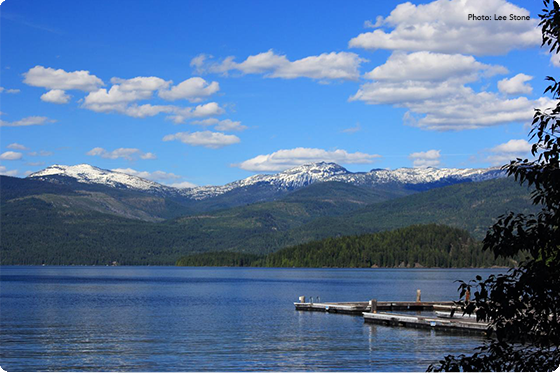Blog
-
Sackett II and its Ripple Effects: Uncertainty Remains for Developers and Communities
- June 27th, 2024 — by Patricia McKee — Category: Clean Water Act
- Tweet
-

In May 2023, the U.S. Supreme Court issued an opinion in Sackett v. EPA (2023), also known as Sackett II, significantly curtailing federal regulatory authority for wetlands.1 The Court adopted a stricter definition of “waters of the United States,” including only those wetlands with a continuous surface connection to traditional interstate navigable waters. This rule has subsequently faced legal challenges.
Sackett involved Michael and Chantell Sackett, who purchased land near Priest Lake, Idaho, in 2004.2 When the couple began filling their property to prepare for construction, the EPA issued a compliance order declaring that the Sackett’s property contained protected wetlands.3 The order instructed the Sacketts to cease development and restore the site or accrue substantial fines.4 In the preceding case, Sackett I, the couple successfully proved that the order constituted a final agency action, activating the Administrative Procedure Act (APA).5 Moreover, the Sacketts would not receive an adequate remedy without prompt court intervention. In Sackett II, the Sacketts argued their land was not subject to the Clean Water Act (CWA). The Supreme Court agreed, restricting the number of wetlands subject to federal jurisdiction to those “indistinguishable” from traditional navigable waters.
In August 2023, the EPA amended its “Revised Definition of ‘Waters of the United States” to comply with the Court’s decision.6 The new rule has resulted in immediate and long-term uncertainties. Twenty-four states depend solely on the CWA for wetland protection.7 States must reconcile their independent protections for wetlands or lack thereof. Moreover, this uncertainty presents a significant challenge for land use planners as landowners request clarity on their particular situations.
Developers must determine whether a particular wetland falls under federal jurisdiction or if state regulations may differ. For example, Robert D. White, a landowner in North Carolina, challenged the post-Sackett rule, arguing it was expansive and vague.8 In his lawsuit, White claimed that its rule lacks clarity, inhibiting him from identifying the federally-protected wetlands on his property and delaying development. This case is pending.
The post-Sackett II rule could also allow polluting facilities to discharge into previously protected waters, worsening health problems in communities affected by environmental injustices. For example, recently, a plastics producer, Formosa Plastics, applied for a wetlands permit to construct a petrochemical complex in St. James Parrish, Louisiana.9 This community, infamously called “Cancer Alley,” has become notorious for its high cancer incidence.10 Residents of “Cancer Alley” endure severe pollution from the almost 200 fossil fuel and petrochemical facilities concentrated within an 85-mile area.11 While Formosa Plastics cannot initiate construction without authorization from the U.S. Army Corps of Engineers, many wetlands now cannot rely on federal intervention to protect them from these types of projects.
The Supreme Court’s decision in Sackett II has restructured the CWA’s regulatory framework. This shift has created uncertainties for developers and landowners, like Robert D. White, and communities reliant on federal protections, such as St. James Parrish. As litigation continues and clarification emerges, Sackett II remains pivotal in shaping future policy and legal discussions.
To learn more, see:
- Anna Todd, Sackett v. EPA and the Definition of Waters of the United States, Harv. L. Sch. Env't & Energy L. Program (June 24, 2022)
- Jeff Turrentine, What the Supreme Court’s Sackett v. EPA Ruling Means for Wetlands and Other Waterways, NRDC (June 5, 2023)
- Bobby Magill, Wetlands Face Challenges on Multiple Fronts After Sackett Ruling, Bloomberg L. (Apr. 18, 2024)
1 Sackett v. EPA, 598 U.S. 651 (2023).
2 Sackett v. EPA, 566 U.S. 120 (2012).
3 Id. at 122.
4 Id. at 124–125.
5 Id. at 126.
6 Revising the Definition of “Waters of the United States,” U.S. Env't Prot. Agency (Sept. 8, 2023), at 126.
7 James M. McElfish, Jr., What Comes Next for Clean Water? Six Consequences of Sackett v. EPA, Env't L. Inst. (May 26, 2023).
8 White v. United States EPA, No. 24-CV-00013, 2024 U.S. Dist. LEXIS 88727 (E.D.N.C. May 15, 2024).
9 Rise St. James v. La. Dep't of Env't Quality, 383 So. 3d 956 (La. Ct. App. 2024).
10 Id. at 24.
11 US: Louisiana’s ‘Cancer Alley’, Hum. Rts. Watch (Jan. 25, 2024).
Stay Current with
Our Publications
Subscribe today to our free
quarterly publication, The SandBar
— and to our monthly newsletter,
the Ocean and Coastal Case Alert.
Blog Post Archive
2025
2024
2023
2022
2021
2020
2019
2018
Blog Post Categories
Admiralty Aquaculture
Clean Water Act
COVID-19
Coastal Management
Endangered Species
Environmental Justice
Environmental Law
Fisheries
Flooding
Groundwater
Hurricanes
Insurance
Invasive Species
Litigation Briefs
Marine Debris
Marine Monuments
Miscellaneous
Natural Disasters
Offshore Energy
OSHA
PPP
Seafood
Staff
Torts
Water Quality











